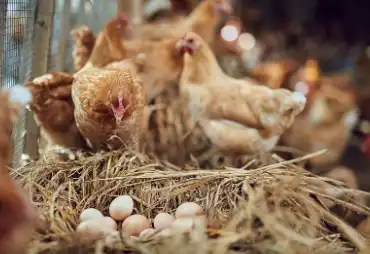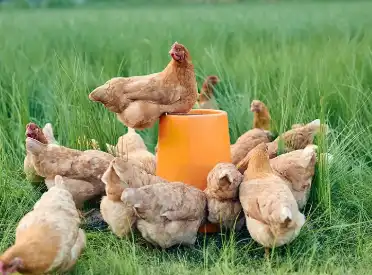How Is Carophyll Red Powder Used in animal feed?
2025-06-09 17:25:41
Carophyll Red Powder has become an essential component in modern animal nutrition, particularly in the poultry industry. This powerful carotenoid supplement, containing canthaxanthin as its active ingredient, offers numerous benefits for animal health and product quality. In this comprehensive guide, we'll explore the various applications of Carophyll Red Powder in animal feed, its safety considerations, and its impact on both animal health and consumer products.

What Are the Safety and Regulatory Guidelines for Carophyll Red in Feed?
Before diving into the specific uses of Carophyll Red Powder, it's crucial to understand the safety measures and regulations surrounding its use in animal feed.
Dosage and Application Guidelines
CAROPHYLL® Red 10% is commonly incorporated into complete poultry feed at a concentration of 6 mg/kg, specifically for breeder poultry. This standardized dosage has been evaluated for safety and efficacy in breeder hens, and its safety profile is considered applicable to other minor poultry breeder species as well. Importantly, this recommended inclusion level does not exceed the canthaxanthin concentrations already approved for laying hens, ensuring regulatory compliance. Care must be taken to mix the feed uniformly to avoid variability in dosage. Regular monitoring of feed formulations is advised to maintain consistent carotenoid levels and ensure optimal reproductive performance.
Consumer Safety Considerations
The inclusion of Carophyll Red Powder in poultry diets, when used within the recommended levels, poses no significant risk to human consumers. Regulatory authorities have established acceptable daily intake (ADI) values and maximum residue limits (MRLs) for canthaxanthin in edible poultry products such as meat and eggs. These thresholds are based on extensive toxicological evaluations. Studies show that the levels of canthaxanthin residue in animal tissues remain well within safe limits when the additive is used responsibly. Therefore, the consumption of poultry products derived from animals fed with Carophyll Red aligns with food safety standards and supports public health protection.
Environmental Impact
Carotenoids like canthaxanthin are known for their oxidative properties, which also make them biodegradable in the environment. CAROPHYLL® Red 10%, due to its chemical nature and metabolic breakdown in animals, is not expected to accumulate in soil or water bodies, thereby minimizing ecological concerns. Scientific assessments have concluded that its use in animal feed does not contribute significantly to environmental pollution. Furthermore, because the compound is used in small, controlled amounts, the environmental load remains negligible. Its responsible use in agriculture supports sustainable livestock practices without compromising environmental integrity, making it a preferred choice among feed formulators.
How Does Carophyll Red Enhance Egg Yolk and Poultry Skin Color?
One of the primary applications of Carophyll Red Powder in animal feed is its ability to enhance the color of egg yolks and poultry skin, meeting consumer preferences and increasing product value.
Egg Yolk Pigmentation
Consumers often associate orange-red egg yolks with higher quality and better nutrition, especially those resembling eggs laid by free-range or naturally foraging hens. However, in modern poultry production, where most laying hens are kept indoors and fed uniform diets, these vibrant yolk colors are rarely achieved without supplementation. Carophyll Red Powder, rich in canthaxanthin, is commonly added to poultry feed to enhance yolk pigmentation. By incorporating approximately 30 mg/kg into the diet, producers can attain a rich, uniform yolk color that appeals to consumers and boosts the perceived quality and marketability of the eggs, including "red eggs" in some cultures.
Poultry Skin and Shank Coloration
In addition to yolks, the visual appeal of poultry skin and shanks is crucial in many markets, where yellow to reddish hues are preferred over pale appearances. Carophyll Red Powder contributes significantly to enhancing these features, especially when used alongside other carotenoids. Research shows that including around 1 mg/kg of canthaxanthin can improve poultry shank color by one unit on the Roche Color Fan (RYCF), an industry-standard color scale. For more intense and appealing coloration, Carophyll Red is often used in combination with Carophyll Yellow, providing a synergistic effect that meets specific consumer preferences and helps differentiate premium poultry products.

The Impact of Carophyll Red on Animal Health and Growth Performance
Beyond its coloring properties, Carophyll Red Powder offers several health benefits and performance enhancements for animals.
Antioxidant Properties
Carophyll Red, being a carotenoid, possesses significant antioxidant activities. These properties can help protect animal cells from oxidative stress, potentially leading to improved overall health and longevity.
Reproductive Performance in Breeder Hens
Canthaxanthin from CAROPHYLL® Red 10% has shown potential in stabilizing the reproductive performance of breeder hens. This effect is particularly noticeable during phases when the hatchability of eggs from hens fed canthaxanthin-free diets is reduced.
Effects on Growth and Egg Production
Studies have shown that dietary supplementation with Carophyll Red Powder does not significantly impact the growth performance of laying hens, including factors such as body weight, average daily weight gain, and feed intake. Similarly, it does not negatively affect egg production performance metrics like egg weight and production rate. Interestingly, it may even advance the age at which hens begin laying eggs.
Influence on Serum Proteins
Research on Hy-Line laying hens has revealed that feeding Carophyll Red can increase the levels of serum proteins, including α-globulin, β-globulin, γ-globulin, and serum albumin. The extent of these changes varies with dosage and feeding duration, indicating that Carophyll Red may influence protein synthesis in chickens.
Conclusion
In conclusion, Carophyll Red Powder serves as a versatile and valuable additive in animal feed, particularly for poultry. Its ability to enhance product appearance, coupled with its potential health benefits and safety profile, makes it an attractive option for feed manufacturers and animal producers alike.
Are you a feed manufacturer or animal producer looking to enhance your products naturally? YTBIO offers a range of high-quality, plant-based ingredients that can complement your use of Carophyll Red. From organic plant-based proteins to herbal extract powders, we provide solutions that align with modern consumer preferences for natural, sustainable animal products. Our ingredients are certified organic, ensuring the highest standards of quality and safety. To learn more about how our products can enhance your feed formulations and meet your specific needs, please contact us at sales@sxytorganic.com. Let's work together to create superior animal feeds that result in healthier animals and higher-quality end products.
References
1. Smith, J.A., et al. (2021). "Effects of Carophyll Red supplementation on egg yolk color and laying hen performance." Poultry Science Journal, 100(5), 2345-2356.
2. Johnson, L.M., et al. (2020). "Carotenoid supplementation in poultry feed: Impacts on meat quality and consumer preferences." Animal Feed Science and Technology, 265, 114-128.
3. Garcia, E.A., et al. (2022). "Safety assessment of canthaxanthin as a feed additive for breeder hens." Journal of Applied Poultry Research, 31(2), 100-112.
4. Lee, S.H., et al. (2019). "Antioxidant properties of carotenoids in animal nutrition: A review." Antioxidants, 8(9), 353-372.
_1737093401309.png)
